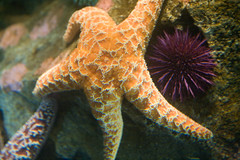Ninja-like crustacean
Excerpt from the Blue Planet.
Do you have a question for the Beach Chair Scientist? e-mail info@beachchairscientist.com.
National Wear Blue for Oceans Day – January 13, 2010
What: Wear Blue for Oceans Day
Who: You and thousands of other that want to protect, maintain and restore the oceans, coasts, estuaries and Great Lakes
Where: Lafayette Park, across from the White House
When: January 13, 2010 at noon – Tomorrow, tomorrow, tomorrow, tomorrow!
Why: To let the Obama Administration know you support a national oceans policy
Don’t forget … if you have any questions e-mail info@beachchairscientist.com.
Image (c) me.
Love Our Blue
In honor of National Wear Blue for Oceans Day this January 13, 2010 here is a little ditty to get you amped … Lyrics amended from the song “Love Me Do” written by the brilliant John Lennon and Paul McCartney of The Beatles.
Love, love our blue.
You know we love blue,
We’ll always be true,
So please, love blue too.
Whoa, love our blue.
Love, love our blue.
You know we love blue,
We’ll always be true,
So please, love blue too.
Whoa, love our blue.
Some blue to love,
Some sea so blue.
Some blue to love,
Some sea so blue.
Love, love our blue.
You know we love blue,
We’ll always be true,
So please, love blue too.
Whoa, love our blue.
Love, love our blue.
You know we love blue,
We’ll always be true,
So please, love our blue.
Whoa, love our blue.
Yeah, love our blue.
Whoa, oh, love our blue.
Answers to “Test your knowledge of sea stars”
Answers to “Test your knowledge of sea stars” from December 31, 2009.
True or False: Sea stars are fish. They are echinoderms, a group of invertebrates. Invertebrates have no backbones. All fish have backbones.
True or False: Sea stars are closely related to sea cucumbers, sea urchins and brittle stars.
True or False: Sea stars have a flexible skeleton.
True or False: Sea stars breathe through gills. They breathe through a water vascular system. You can see the tube feet (a main component of the water vascular system) on the underside of the sea stars.
True or False: Sea stars can regenerate most body parts.
Congrats to all those that got them correct!
A plea of the manatee
 In early 2009 the Florida Fish and Wildlife Conservation Commission (FWCC) reported that there was a significant increase in the population of the West Indian Manatee (Trichechus manatus), a marine mammal. Almost a year later it was reported that there was a record number of deaths of manatees.
In early 2009 the Florida Fish and Wildlife Conservation Commission (FWCC) reported that there was a significant increase in the population of the West Indian Manatee (Trichechus manatus), a marine mammal. Almost a year later it was reported that there was a record number of deaths of manatees.
Even though the FWCC pointed out that there may have been more manatees reported in the 2009 populations since the count was done after several cold fronts had clustered the manatees together, was there too much confidence in the public after hearing the news that the public didn’t think they had to participate in best practices to save the manatee? Just an idea.
What are those best practices? Follow no wake signs and do not enter prohibited wildlife sanctuaries, do not feed or touch manatees from a boat, and use snorkel gear (it is not as loud and intrusive to the manatees). Call 1-888-404-FWCC if you were to see an injured, dead, tagged or orphaned manatee.
Do you have a question for the Beach Chair Scientist? E-mail info@beachchairscientist.com.
Image (c) USGS.
Mass stranding of whales in Italy
http://www.istitutotethys.org/gargano/
They suspect a high ingestion rate of plastic bags.
Do you have a question for the Beach Chair Scientist? E-mail info@beachchairscientist.com
Test your knowledge: Sea stars
1. True or False: Sea stars are fish.
2. True or False: Sea stars are closely related to sea cucumbers, sea urchins and brittle stars.
3. True or False: Sea stars have a flexible skeleton.
4. True or False: Sea stars breathe through gills.
5. True or False: Sea stars can regenerate most body parts.
(Answers can be found here.)
Have a question for the Beach Chair Scientist? E-mail info@beachchairscientist.com.
Swiped bass
The striped bass (Morone saxatilis) is the state fish of Maryland, Rhode Island, South Carolina, and the state saltwater fish of New York and New Hampshire. The fish is commonly referred to as the rockfish. The fish supports a $6.5 billion per year industry with 60,000 jobs as a recreational game species. Read more about this in the November 22, 2009 article in the Washington Times, “Anglers serve time for black-market rockfish trade” by Jim McElhatton.
Image (c) Fish and Wildlife Service via wikimedia
If you have any questions please e-mail beachchairscientist@gmail.com or let us know at http://www.beachchairscientist.com.
The Fisheries Industry is a Ponzi Scheme?
Yes, it is unfortunate. Please read the article from the New Republic  “Aquacalypse Now: The End of Fish” by Daniel Pauly (pictured) to find out more.
“Aquacalypse Now: The End of Fish” by Daniel Pauly (pictured) to find out more.
Daniel Pauly is a professor at the Fisheries Centre of the University of British Columbia and the principal investigator of its Sea Around Us Project.
Image (c) carmelfinley.wordpress.com










What people are saying …